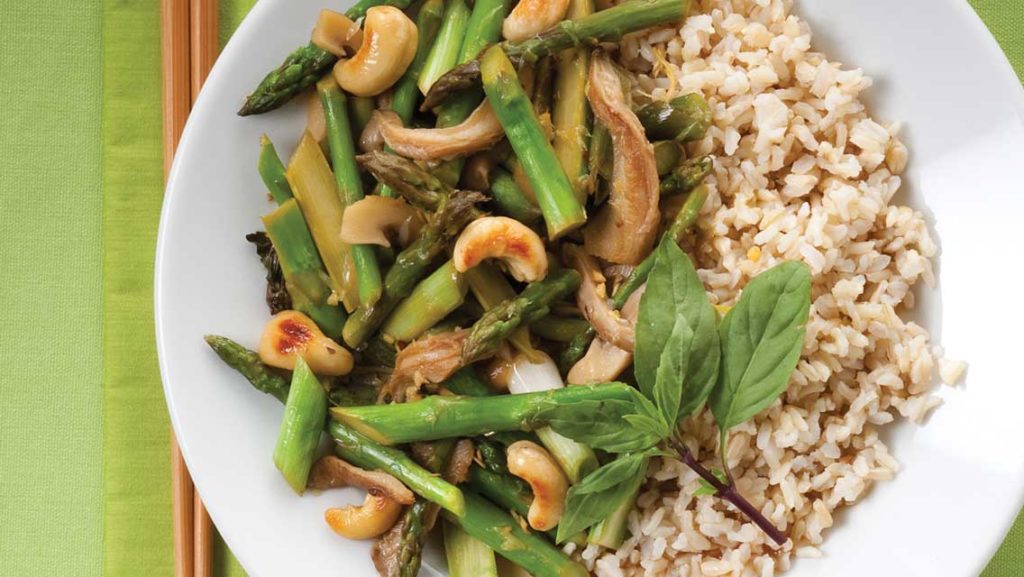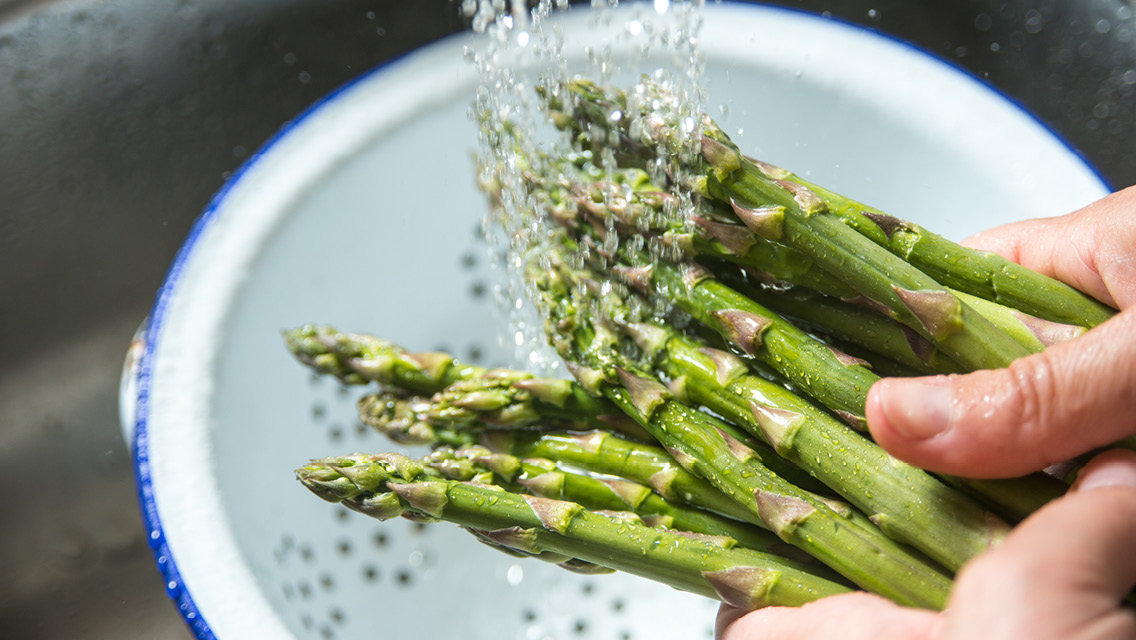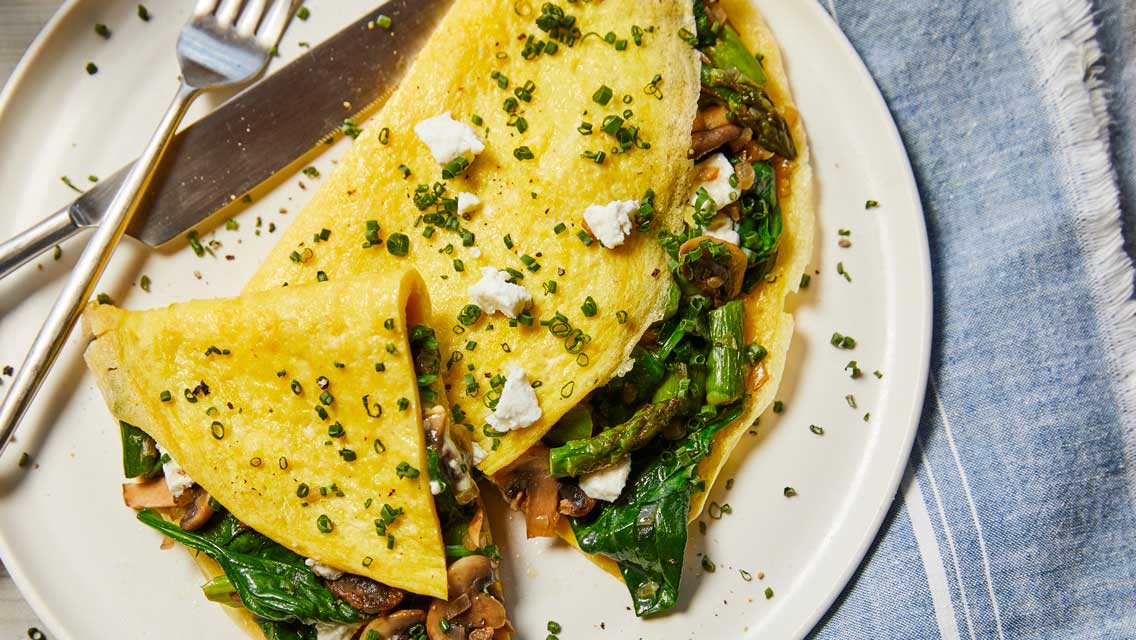Pity the poor asparagus. In a world filled with trendy veggies like kale and Brussels sprouts, asparagus is often overlooked or, worse, overcooked. But this unassuming perennial, prized for its delicate flavor and grace, really deserves to be celebrated when it appears in spring. It is simple to prepare, adds color and crispness to seasonal dishes, and is unendingly versatile. It’s also rich in nutrients that actively support your health. Asparagus tastes best at the beginning of the growing season, so treat your body and fill your plate with the fresh stuff soon.
Quick and Easy
Five simple ways to prepare asparagus.
- Quick pickled: Pickle asparagus by blanching and adding it to a rice-wine-vinegar brine. Mix it into your favorite salad, put it on a sandwich, or use it as an accompaniment to grilled meats and fish.
- Sautéed: Asparagus cooks quickly when sautéed in a hot pan with butter, or coconut, sesame or olive oil. Toss in some chopped garlic or ginger at the end for a tasty stir-fry.
- Roasted: Dress asparagus with a little olive oil, balsamic vinegar, salt and pepper, and oven roast at 400 degrees F until just tender.
- Raw: Using a mandoline, grater or sharp knife, thinly slice raw asparagus and use in your favorite salad.
- Steamed or grilled: Steam asparagus in a bamboo steamer and serve, warm or chilled, with a drizzle of your favorite vinaigrette. If it’s hot outside, try grilling (coat stalks in a little olive oil first). To prevent the asparagus from falling through the grill grates, secure five to six spears horizontally with bamboo skewers.
Mix It Up
Asparagus comes in a trio of colors that can be used interchangeably in recipes.
Green — Sprouts early in the spring, and it comes from a perennial plant. You can find green asparagus year-round in most grocery stores, but it’s most flavorful and nutritious when purchased locally and in season.
White — When the asparagus plant is mounded with dirt while growing, depriving the usually green stalks of light, the plant doesn’t produce chlorophyll. The result is white asparagus. Milder in flavor and a bit more tender than green, white asparagus is the preferred color in Europe.
Purple — A variety that originated in Italy, purple asparagus is gorgeous raw in salads or on a vegetable tray. It’s slightly smaller and, some think, a touch fruitier than green. When cooked, however, purple asparagus looks and tastes very much like its green cousin.
Shopping and Storage Tips
- Scout out locally grown asparagus at the start of the growing season. Depending on where you live, that’s usually April or May.
- Size does not affect flavor. The thickness of the asparagus is based on the age of the plant; stalks come out of the ground either thin or thick. Instead, choose based on use: Thin is great raw, thick is terrific grilled.
- Over time, asparagus loses its flavor and develops a woody texture, so buy it as fresh as possible. When shopping, avoid withered spears and check the cut stem end for signs of drying.
- To store, trim the stems and stand them in a glass with 1 to 2 inches of water or wrap a damp cloth around the base of stalks. Cover with a plastic bag and refrigerate for up to two days.
Kitchen Tricks
- Asparagus is grown in sandy soil, so make sure to wash thoroughly to get the grit out of the tips.
- Before cooking, remove each stalk’s fibrous white base. A simple method is to hold the top half of a spear with one hand and the bottom half between the thumb and forefinger of the other. Bend the spear until it snaps right where the tender part meets the tougher end. (Save the tougher ends for soup or stock.)
- The key to preparing asparagus is to not overcook it. Whatever the cooking method, you’ll know asparagus is ready when it’s al dente, hot and tender but still maintaining a slight crispness.
- Avoid cooking asparagus in iron pots. The tannins in asparagus react to the iron, causing discoloration and an off-putting iron taste.
Nutrition Know-How
- Recent research has shown that asparagus contains saponins, phytonutrients that fight inflammation and chronic diseases such as cancer. They also help with blood pressure and blood-sugar regulation.
- Asparagus is also rich in glutathione, vitamin C, beta-carotene, vitamin E and several flavonoids that make it an anti-inflammatory and antioxidant powerhouse.
- Inulin, a prebiotic, is found in asparagus (as well as in chicory root, Jerusalem artichoke and other foods). It helps nourish probiotic (good) bacteria in the large intestine that improves nutrient absorption and balances biochemistry while lowering the risk of allergies and many chronic diseases. Because asparagus is also high in fiber, it’s excellent for digestive health.
- High amounts of B vitamins in asparagus help lower blood levels of the amino acid homocysteine and contribute to heart health.
Asparagus Recipes
Thai-Style Stir-Fry with Asparagus, Cashews and Oyster Mushrooms
A light stir-fry that showcases the delicate flavor of asparagus. Make it a heartier meal by adding tofu, meat or seafood.

Makes | four servings
Ingredients
- 1 tbs. coconut oil
- 2 tbs. finely chopped gingerroot
- 2 tbs. finely chopped lemongrass or 1 tbs. fresh lemon or orange zest
- 1/2 cup raw cashews
- 1 Thai chili or jalapeño pepper, finely chopped, optional
- 1 bunch asparagus, about 2 cups, cut into 1-inch pieces
- 1 cup scallions, cut into 1-inch pieces
- 1 cup oyster mushrooms, cut into strips
- 1/2 cup fresh orange juice
- 2 tbs. tamari
- 1/2 cup Thai basil leaves
Directions
- Heat the coconut oil in a heavy skillet, and sauté the ginger, lemongrass, cashews and Thai chili until the cashews are golden brown. Remove from skillet and set aside.
- Add the asparagus, scallions and mushrooms to the hot skillet and cook until almost tender.
- Add the orange juice and tamari and cook for one to two minutes.
- Remove from heat and stir in cashew mixture and Thai basil leaves. Serve with brown rice or as a side dish.
Hot and Sour Soup with Asparagus
This soup is very quick to prepare and can also be made with chicken, pork or beef. Add a handful of chopped baby bok choy, Napa cabbage or kale if you want more greens.

Makes | four to six servings
Ingredients
- 4 cups vegetable or chicken stock
- 1 tbs. fresh gingerroot, minced
- 8 shiitake mushrooms
- 1 carrot, sliced thinly into small sticks
- 1 bunch asparagus, cut into 1-inch pieces
- 1/4 cup chopped green onions
- 1 cup 1/2-inch cubes of firm tofu
- 4 tbs. sherry vinegar
- 2 tbs. tamari
- 1 tsp. toasted sesame oil
- 1 tsp. Sriracha chili sauce, or to taste
- 1 cup bean sprouts and/or microgreens for garnish
Directions
- Bring stock to a simmer in a medium saucepan and add the ginger, mushrooms and carrots. Simmer until vegetables are almost tender.
- Stir in the remaining ingredients and simmer until the asparagus is just cooked through.
- Serve warm, garnished with bean sprouts and microgreens.
Sesame Seared Salmon with Asparagus Slaw
This fresh and vibrant slaw is a great way to serve asparagus in its natural state, and is excellent with fish or seafood. Feel free to experiment with various herbs, such as mint, cilantro or parsley.

Makes | four servings
Ingredients
- 1 bunch asparagus, trimmed
- 8 radishes, trimmed
- 1 carrot, peeled
- 1 fennel bulb, trimmed
- 1 tbs. chopped fresh dill
- Zest and juice of one lemon
- 2 tbs. olive oil
- Salt and freshly ground black pepper
- 1/3 cup sesame seeds
- 1/4 tsp. cayenne pepper (optional)
- 4 salmon fillets, skin on
- 2 tbs. ghee (clarified butter)
Directions
- Preheat the oven to 375 degrees F.
- For the slaw: Slice the asparagus, radishes, carrot and fennel thinly by hand, with a mandoline, or with a fine-slicer blade in a food processor.
– Toss with chopped dill, lemon zest and juice, and olive oil. Season with salt and pepper.
– Chill the slaw while you prepare the salmon. - For the salmon: Toss the sesame seeds in a shallow bowl with the cayenne pepper (if you are using it). Season the salmon with salt and pepper, and press the side without skin into the sesame seeds to coat.
– Heat the ghee in a heavy ovenproof skillet over high heat and add the salmon, sesame-seed-side down.
– Sear the salmon until the sesame seeds are browned, about one to two minutes. Turn heat down to medium, flip the salmon fillets over, and sear the skin side for one to two minutes.
– Transfer the salmon to the oven to finish, about five to 10 minutes depending on how you like it.
– Serve with the asparagus slaw.
Italian Roasted Asparagus With Walnuts and Parmesan cheese
A quick side dish that can be adapted in so many ways. Try a different combination of citrus, nuts and cheese, such as orange zest, pistachio and Pecorino. For a cheeseless version, try lime zest, almonds and fine shredded coconut.

Makes | four servings.
Ingredients
- 1 tbs. olive oil
- 1 bunch asparagus, trimmed
- 2 cloves garlic, finely minced
- Zest of one lemon
- 1/2 cup finely chopped walnuts
- 1/4 cup shredded Parmesan cheese
- Salt and freshly ground black pepper
Directions
- Heat oven to 450 degrees F.
- Drizzle a baking sheet with olive oil and arrange the asparagus in a single layer on the baking sheet.
- Mix the garlic, lemon zest, chopped walnuts, shredded cheese, and salt and pepper together in a small bowl.
- Sprinkle the cheese and nut mixture over the asparagus and bake until golden brown, about 10 to 15 minutes.
Love at First Bite
Chef Annie Somerville first fell in love with asparagus in 1985, when she started cooking at Greens, a celebrated vegetarian restaurant in San Francisco where she is currently executive chef. “After a long winter with root vegetables,” she says, “asparagus is one of the real harbingers of spring.” Somerville is the author of Fields of Greens: New Vegetarian Recipes from the Celebrated Greens Restaurant and Everyday Greens. She talked with us about simple ways to prepare and enjoy one of the season’s tastiest treats.
EL | What is your favorite way to eat asparagus?
AS | I love it grilled over coals. I also love it roasted in the oven at 400 degrees; it’s kind of crispy and it caramelizes a little bit.
EL | What are some simple ways to prepare asparagus?
AS | You can grill it or blanch it and toss it with lemon juice and zest, olive oil, and salt and pepper. Or you can drizzle some vinaigrette over the grilled or blanched asparagus and serve it on a beautiful salad with fresh goat cheese. Asparagus and beet salad with vinaigrette is really yummy, too.
It’s also delicious as a raw ingredient. I like to shave raw spears, toss them with some olive oil and salt and pepper, and put that over a bed of greens. It can also be thinly sliced and tossed with pasta or put on top of a pizza.
EL | Does diameter make a difference when cooking?
AS | The thicker stalks are better for roasting or grilling because they hold up better under the heat, but you can grill all the way from pencil-size to jumbo. Pencil-thin or medium-size are good for slicing. You can toss them right into a skillet if you’re making pasta or risotto, and they won’t take long to cook at all. A lot of it is just preference.
EL | What would you say to someone who is nervous about cooking asparagus?
AS | A really easy way to prepare asparagus is to simply steam it for two to three minutes and serve it. You want it to be just on the edge of tender.
If you’re having a party, I recommend blanching the asparagus and shocking it in cold water ahead of time. That way it will remain bright green and crisp. Toss with vinaigrette just before serving.
EL | What are the most common mistakes people make in cooking asparagus?
AS | Overcooking it and dressing it too early. If you’re going to dress it with any acidic ingredients, then do that right before you serve it, because otherwise it loses its bright color, luster and texture.
EL | What flavors pair well with asparagus?
AS | I love asparagus and peas. A fresh salad of English peas, snap peas, snow peas — any peas paired with asparagus is the epitome of spring. I also love asparagus with anything that brightens its flavor, such as citrus or radishes.




This Post Has One Comment
[…] example, if it’s spring, look for spring favorites like asparagus, artichokes, radishes and rhubarb. We are used to buying these items at any time, but eating them […]